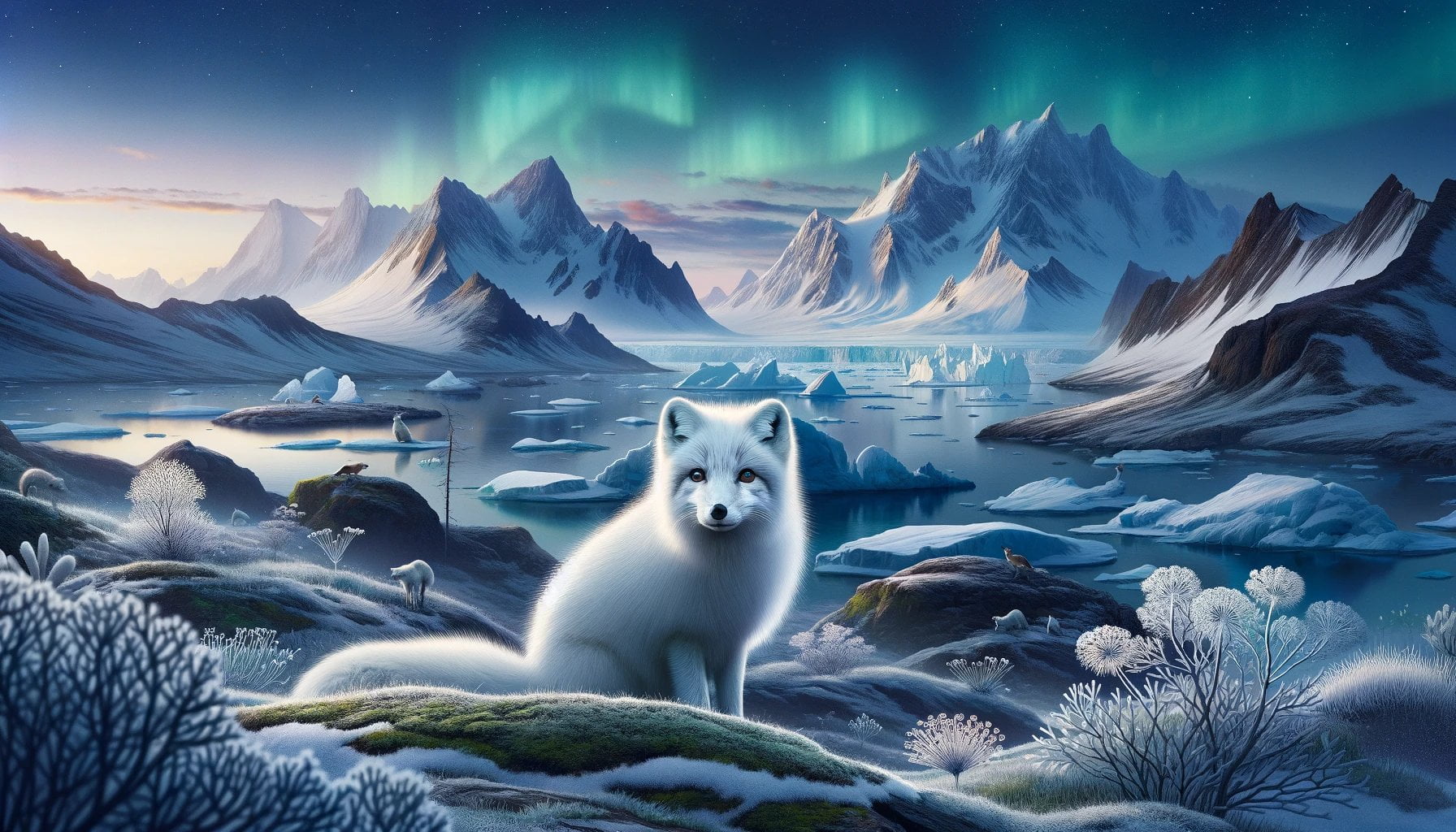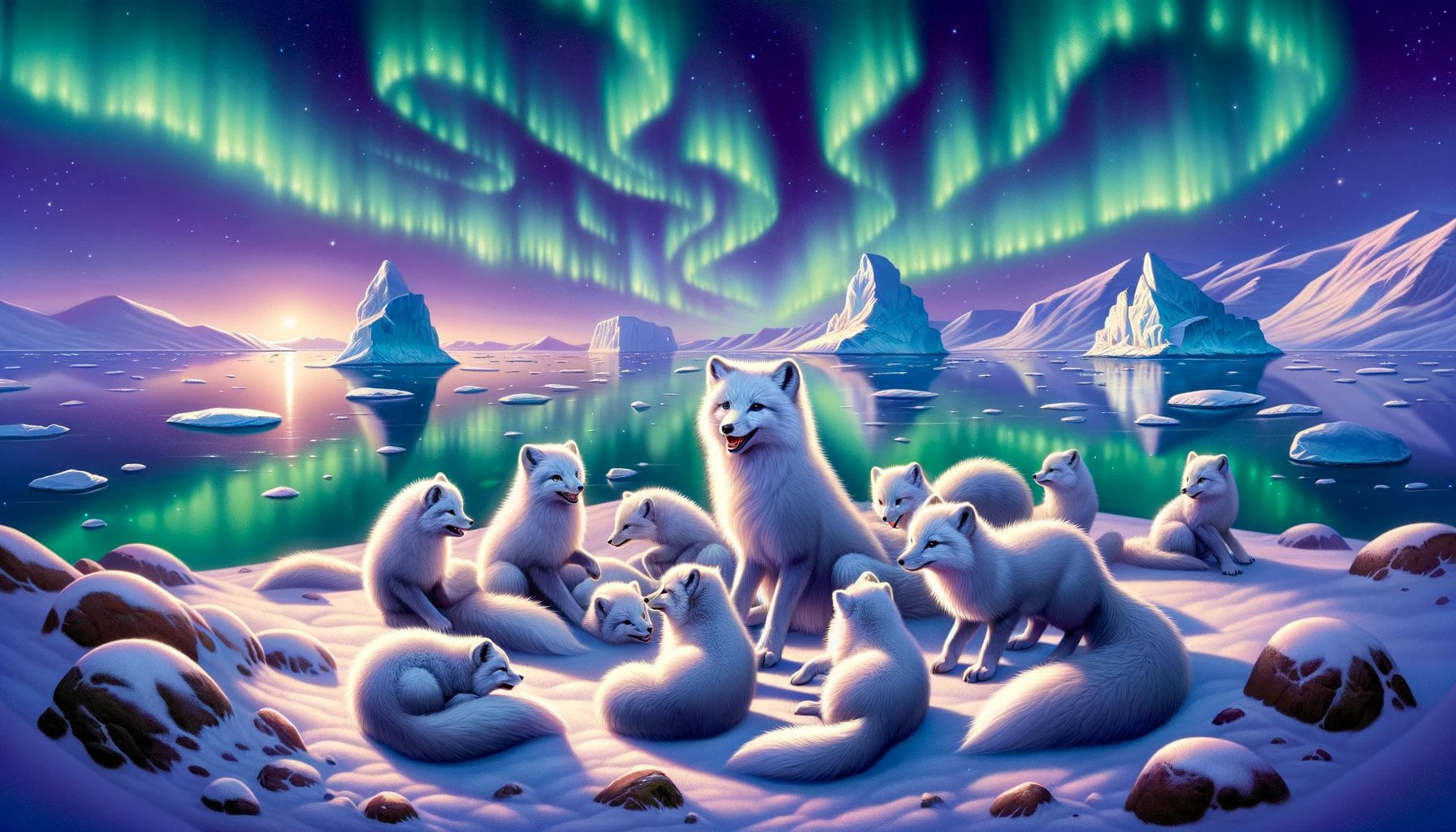The Arctic fox, with its enigmatic presence in the vast expanse of the Arctic region, holds a myriad of captivating secrets waiting to be unveiled. In this article, we will delve into the world of this remarkable creature and discover 10 intriguing facts that will leave you in awe of its extraordinary abilities and adaptations. From its stunning fur color changes to its remarkable skill of survival in the harshest of environments, the Arctic fox is a testament to the wonders of nature. So, let us embark on this fascinating journey and unravel the mysteries of the Arctic fox together.

Key Takeaways:
- Arctic foxes are skilled travelers, capable of covering long distances in search of food and suitable habitats.
- They have lower body temperatures compared to other mammals, enabling them to conserve energy and stay warm in extreme cold.
- Arctic foxes possess the remarkable ability to change their fur color with the seasons, aiding camouflage with their surroundings.
- They form monogamous pairs and mate for life, working together to raise their young.
- Lemmings make up a significant portion of the Arctic fox’s diet, along with birds, eggs, fish, and occasional scavenged food.
- Due to their remote habitat, Arctic foxes have few natural predators, but are threatened by diseases, parasites, and human-introduced predators.
- In captivity, Arctic foxes have been known to live for up to 18 years or longer.
- These creatures have an incredible sense of smell, capable of detecting the scent of a seal den from a mile away.
- Arctic fox dens can be as old as 300 years and are used for generations, providing shelter and protection from the harsh Arctic climate.
- Arctic foxes have small ears, reducing heat loss by exposing less of the ear to the cold.
10 Interesting Facts About the Arctic Fox
The Arctic fox is a remarkable creature that has adapted to thrive in the harsh conditions of the Arctic. Let’s delve into 10 intriguing facts about these fascinating animals:
1. Arctic foxes travel long distances
Arctic foxes are known for their resourcefulness and ability to cover vast areas in search of food and suitable habitats[^1]. They are adept at navigating the vast expanse of the Arctic, making them highly adaptable creatures.
2. They have lower body temperatures compared to other mammals
To survive in extreme cold, Arctic foxes have evolved with a lower body temperature compared to other mammals. This enables them to conserve energy and stay warm in freezing conditions[^2].
3. Arctic foxes change color with the seasons
One of the most remarkable abilities of Arctic foxes is their ability to change their fur color with the seasons. Their fur is white in winter, providing excellent camouflage against the snowy landscape, and turns brown or gray in summer to blend with their surroundings[^4][^7].
4. They mate for life
Arctic foxes are monogamous creatures. They form lifelong partnerships and work together to raise their young pups[^9]. This strong sense of family and commitment makes them incredibly endearing.
5. Their favorite food is lemmings
Lemmings are a significant part of the Arctic fox’s diet. These small rodents provide a crucial source of sustenance for these adaptable creatures. Additionally, Arctic foxes also consume birds, eggs, fish, and occasionally scavenge food from the kills of polar bears and wolves[^12][^13].
6. Arctic foxes have few predators
Due to their remote and harsh habitat, Arctic foxes have few natural predators. Their main threats come from diseases, parasites, and predators introduced by human activities[^17]. Despite these challenges, Arctic foxes have managed to thrive in their environment.
7. They can live for up to 18 years or longer in captivity
In captivity, Arctic foxes have been known to live for up to 18 years or even longer[^5]. This remarkable lifespan showcases their resilience and adaptability in the face of adversity.
8. An Arctic fox can smell a seal den a mile away
Arctic foxes possess an incredible sense of smell. They can detect the scent of a seal den from a mile away[^4]. This remarkable ability helps them locate potential food sources in the vast Arctic landscape.
9. Arctic fox dens are used for generations
Some Arctic fox dens can be as old as 300 years and are used for generations. These dens provide shelter and protection from the harsh Arctic climate[^6][^15]. These burrows serve as a safe haven where young foxes are nurtured and protected.
10. Arctic foxes have small ears, which reduces heat loss
The small ears of Arctic foxes help in reducing heat loss. By minimizing the exposed surface area to the cold, these creatures can conserve body heat more effectively[^6].
In conclusion, the Arctic fox is a captivating creature with remarkable adaptability and unique characteristics. These 10 interesting facts provide a glimpse into the world of these resilient animals and emphasize their significance in the Arctic ecosystem. By uncovering the mysteries of the Arctic fox, we gain a deeper appreciation for the wonders of nature and the incredible adaptations that enable wildlife to thrive in extreme environments.
Learn more about Arctic foxes:
Coral reefs are fascinating ecosystems, and there are many interesting facts about them. Did you know that coral reefs are made up of tiny animals called polyps? Find out more about these incredible underwater structures by clicking on this link: 10 interesting facts about coral reefs.
The Great Barrier Reef is a natural wonder that is home to an abundance of marine life. If you want to uncover some incredible facts about this iconic reef, click on this link: 10 facts about the Great Barrier Reef.
Diet and Hunting Techniques
Arctic Fox Diet: Surviving in the Harsh Arctic
The arctic fox, a small and resilient member of the canine family, has adapted its diet and hunting techniques to survive in the harsh Arctic environment. Let’s delve into the fascinating world of the Arctic fox’s diet and explore its remarkable hunting strategies.
- Lemmings: The Main Course
- The Arctic fox’s favorite food is lemmings, small rodents that inhabit the Arctic tundra.
- Contrary to popular belief, the Arctic fox does not solely rely on lemmings, but they make up a significant part of its diet.
- Lemmings go through population cycles, and the Arctic fox population fluctuates in response to these cycles. When lemming numbers are high, the fox population booms and vice versa.
- Varied Diet
- While lemmings are the Arctic fox’s primary prey, they are opportunistic hunters and will adapt their diet based on availability.
- The resourceful Arctic fox also preys on small animals such as voles, hares, squirrels, and birds.
- They are known to scavenge carrion and feed on eggs, as well as fish when they are accessible.
- Hunting Techniques: Adapting to Extreme Conditions
- The Arctic fox employs various hunting techniques to secure its next meal in the challenging Arctic terrain.
- One such technique involves using their remarkable hearing to detect the faint sounds made by prey scurrying beneath the snow.
- With precise agility and powerful paws, the Arctic fox tirelessly digs through the snow to reveal its well-hidden prey.
- This method, known as “mousing,” allows the Arctic fox to outmaneuver its prey and seize it with speed and accuracy.
- Adapting to Seasonal Changes
- As the Arctic fox navigates seasonal changes, its hunting techniques evolve to accommodate the shifting availability of prey.
- During winter, when lemming populations are plentiful, the Arctic fox relies on its superior sense of hearing and agility to catch these small rodents in their burrows beneath the snow.
- In the summer months, when lemmings are scarce, the Arctic fox adapts its hunting style and widens its diet to include other small mammals, insects, and plant matter.
- Surviving Scarcity: Storing Food
- To cope with the scarcity of food in the challenging Arctic environment, the Arctic fox has developed a unique survival strategy.
- During times of abundance, Arctic foxes are known to cache excess food by burying it in shallow holes and marking the locations.
- These cached food reserves serve as a vital resource during lean periods when prey is scarce, ensuring the fox’s survival during times of scarcity.
Key Takeaways:
- The Arctic fox primarily feeds on lemmings, but also scavenges, preys on small animals, eggs, and fish.
- It uses its exceptional hearing and agile digging skills to locate and capture prey buried beneath the snow.
- The Arctic fox adapts its hunting techniques to seasonal changes and the availability of prey.
- During times of abundance, Arctic foxes store food in shallow holes to sustain themselves during lean periods.
Sources:
– WWF UK
– Wildlife Informer
Reproduction and Family Life
Arctic foxes have some fascinating reproductive and family life traits that contribute to their survival in the harsh Arctic environment. In this section, we will explore the unique aspects of their mating, breeding, and parenting behaviors.
Key Takeaways:
- Arctic foxes are monogamous animals, forming lifelong pair bonds for reproduction and family life.
- They give birth to large litters of 5-8 pups in the spring, usually between February and June.
- The parents work together to raise their pups during the summer months.
- Arctic foxes live in burrows with extensive tunnel systems, providing a safe and warm den for their young.
Arctic foxes are known for their monogamous nature, as they mate for life. This strong bond between a male and a female plays a crucial role in their reproductive success and the growth of their family. Once paired, the mating season begins, usually in the winter months. Their breeding season occurs from February to June, with females giving birth 49-57 days after mating. During this time, the expectant mother seeks out a safe and warm den, often located within the extensive tunnel systems of their burrows.
When the time comes, Arctic foxes give birth to large litters of 5-8 pups, and this occurs in the spring. It is fascinating to observe the parents’ cooperative efforts in raising their young. Both the male and female foxes actively contribute to the care and nurturing of the pups, creating a strong family unit. The male plays an essential role by sourcing food for the growing family and protecting the den from potential predators. This shared responsibility ensures the survival and well-being of their offspring.
Living in burrows with intricate tunnel systems, Arctic foxes provide their young with a safe and warm environment. These burrows serve as an ideal habitat for the fox family, safeguarding them from the extreme Arctic weather and potential threats. The parents diligently care for their pups, ensuring they have the best chance of survival in this challenging environment.
In summary, Arctic foxes exhibit remarkable behaviors when it comes to reproduction and family life. Their monogamous nature, large litters, and cooperative parenting efforts contribute to their success in the Arctic wilderness. By understanding and appreciating these aspects, we gain a deeper understanding of the intriguing world of the Arctic fox.
Citations:
- Arctic Kingdom. (n.d.). 10 Fun Facts About The Arctic Fox. Retrieved from source
- OneKind Planet A-Z. (n.d.). Amazing Facts about the Arctic Fox. Retrieved from source
Outline 5: Threats and Conservation Efforts
The Arctic fox, scientifically known as Vulpes lagopus, is an extraordinary creature that faces numerous threats to its survival. In this article, we will explore the challenges that the Arctic fox encounters and the conservation efforts being implemented to protect this remarkable species.
Threats to the Arctic Fox
- Climate Change: The impacts of climate change pose a significant threat to the survival of the Arctic fox. Rising temperatures result in the reduction of the fox’s snowy habitat, making it increasingly difficult for them to camouflage and hunt effectively.
- Loss of Habitat: The rapid loss of Arctic habitats is a pressing concern for the Arctic fox. As ice melts and sea levels rise, coastal areas where the foxes reside are being compromised. This loss of habitat limits their access to prey and disrupts their reproductive patterns.
- Disease and Predation: Disease and predation further add to the challenges faced by Arctic foxes. Increased contact with domesticated animals exposes them to diseases, and the introduction of predators by humans, such as red foxes, poses a threat to their survival.
- Human Activities: Human activities, including hunting and trapping, contribute to the endangerment of Arctic foxes. While protective measures have been implemented, illegal hunting and trapping still occur, putting additional pressure on the already vulnerable population.
Conservation Efforts
Efforts to conserve the Arctic fox are crucial for its survival and the preservation of the Arctic ecosystem. Here are some notable conservation initiatives:
- Protected Areas: Establishing protected areas is essential for safeguarding the Arctic fox’s habitat. Designating specific regions as protected areas ensures that the foxes have access to suitable breeding grounds and sufficient food sources.
- Awareness and Education: Raising awareness about the plight of the Arctic fox is vital for its conservation. Educational campaigns and initiatives aim to inform the public about the importance of preserving the Arctic ecosystem and the role of the Arctic fox within it.
- Research and Monitoring: Ongoing research and monitoring efforts help gather crucial data on Arctic fox populations and their habitats. This data is used to inform conservation strategies and adapt efforts to better suit the foxes’ needs.
- Mitigating Climate Change: Addressing the root cause of habitat loss, climate change, is key for Arctic fox conservation. Advocacy for reducing greenhouse gas emissions and implementing sustainable practices can help stabilize the Arctic environment.
- Collaboration: Collaboration among scientists, conservation organizations, and local communities is vital for the success of Arctic fox conservation. By working together, these stakeholders can combine their expertise and resources to develop effective conservation strategies.
Key Takeaways:
- The Arctic fox faces numerous threats, including climate change, habitat loss, disease, predation, and human activities such as hunting and trapping.
- Conservation efforts include establishing protected areas, raising awareness, conducting research and monitoring, mitigating climate change, and fostering collaboration among stakeholders.
- Preserving the Arctic fox is crucial for maintaining the delicate balance of the Arctic ecosystem and safeguarding the biodiversity of this unique region.
Sources:
- Arctic Fox Endangered – Threats and Conservation – Mammal Age
- Arctic fox | WWF – Panda

FAQ
Q1: How far can Arctic foxes travel?
A1: Arctic foxes are known to travel long distances, covering vast areas in search of food and suitable habitats.
Q2: What is the average lifespan of an Arctic fox in captivity?
A2: In captivity, Arctic foxes have been known to live for up to 18 years or even longer.
Q3: Do Arctic foxes change their fur color?
A3: Yes, Arctic foxes have the ability to change their fur color with the seasons. They are white in winter and brown or gray in summer, allowing them to camouflage with their surroundings.
Q4: What is the favorite food of Arctic foxes?
A4: Lemmings make up a significant portion of the Arctic fox’s diet. They also eat birds, eggs, fish, and sometimes scavenge food from polar bears and wolves.
Q5: Do Arctic foxes have any predators?
A5: Due to their remote and harsh habitat, Arctic foxes have few natural predators. Their main threats are diseases, parasites, and predators introduced by human activities.
- Sept 31 Myth: Unveiling Calendar Secrets - March 18, 2025
- How Long & Till December 18, 2025: Accurate Countdown Guide - March 18, 2025
- Discover Japanese Artists: A Complete History - March 18, 2025
















